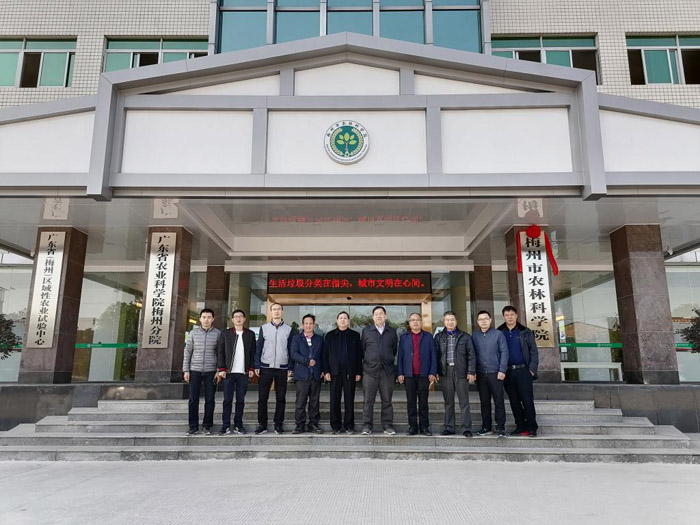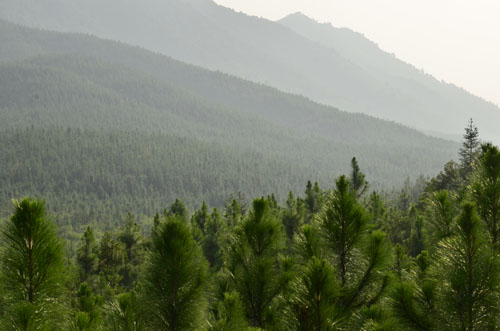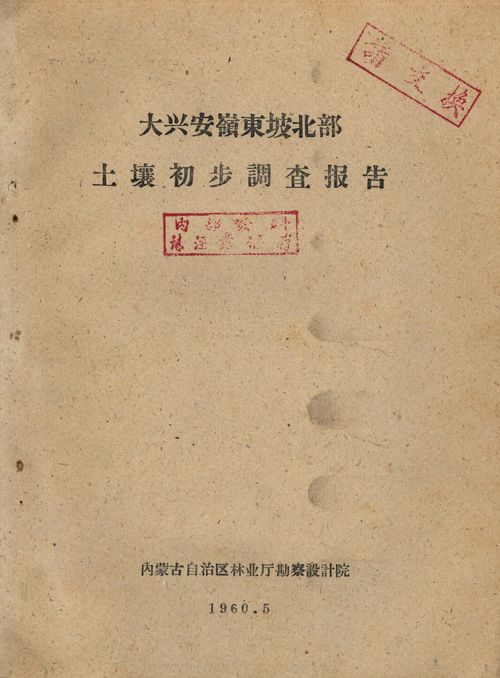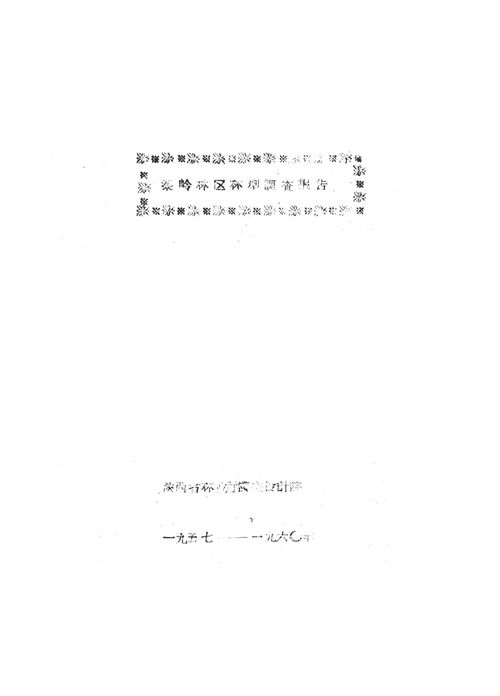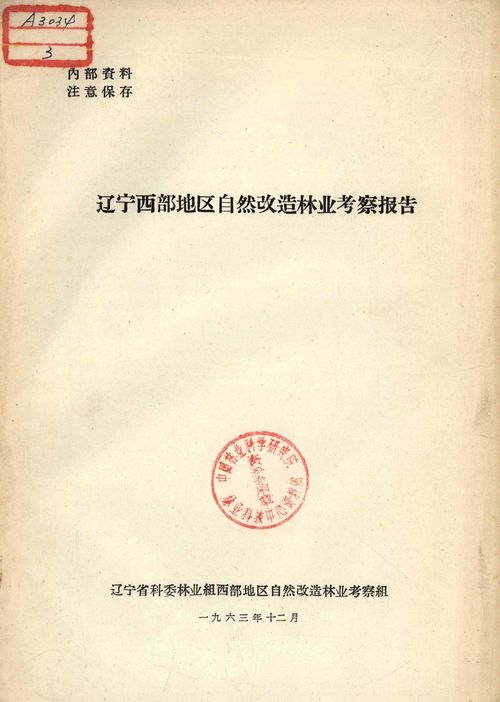
黔北金佛山方竹林碳储量及其影响因素
编号
lyqk011461


中文标题
黔北金佛山方竹林碳储量及其影响因素


作者单位
1. 贵州省林业科学研究院 贵阳 550005;
2. 贵州省新时代竹产业研究院 贵州赤水 564700;
3. 国家林业和草原局丛生竹工程技术研究中心 昆明 650224;
4. 贵州赤水竹林生态系统国家定位观测研究站 贵州赤水 564700;
5. 国家林业和草原局西南喀斯特山地生物多样性保护重点实验室 贵阳 550005


期刊名称
世界竹藤通讯


年份
2024


卷号
22


期号
3


栏目名称
学术园地


中文摘要
竹林碳汇是国际社会关注的热点,其中亚优势层竹林碳汇是观测研究的难点。在黔北大娄山金佛山方竹(以下简称方竹)中心分布区调查了92个样地,其中纯林样地数量占33.70%,分析了纯林及混交林碳储量及组成对方竹林分指标的响应。结果表明:1)纯林及混交林方竹地上部分平均碳储量分别为29.74 t/hm2和30.31 t/hm2,地下部分平均碳储量分别为16.07 t/hm2和18.16 t/hm2,总碳储量分别为45.81 t/hm2和48.47 t/hm2,地下部分碳储量及总碳储量差异显著。不同类型方竹林构件碳储量呈竹秆>鞭根>竹叶>竹枝>竹篼的变化趋势,竹秆碳储量在龄级间比例相近。2)方竹纯林及混交林土壤(土层厚度40 cm)平均碳储量分别为136.36 t/hm2和112.57 t/hm2,二者差异极显著,呈土壤B层>A层的变化趋势。土壤碳储量在A层与B层、A层及B层与AB层间相关极显著。3)方竹纯林及混交林灌木地上部分平均碳储量分别为0.01 t/hm2和0.02 t/hm2,混交林乔木地上部分及凋落物平均碳储量分别为12.63 t/hm2和2.14 t/hm2。4)在纯林及混交林中,方竹碳储量、灌木地上部分碳储量以及植被层(方竹、乔木和灌木)地上部分碳储量与方竹平均胸径及密度二元线型回归式的相关性极显著,混交林方竹平均胸径及密度与土壤A层、B层及AB层碳储量的二元线型回归模型相关显著。研究为评价方竹林碳储量及影响因素提供了科学依据。


基金项目
贵州省特色林业产业科研项目(特林研2020-02);国家林业部课题(1995-林[中]字-21号)。


英文标题
Carbon Storage in Chimonobambusa utilis Forest in North Guizhou Province and Its Influencing Factors


作者英文名
Zhang Xi, Zhang Tingjia, Yang Guangneng, Hou Yiju, Jiang Xia


单位英文名
1. Guizhou Academy of Forestry, Guiyang 550005, China;
2. Guizhou Institute of Bamboo Industry for New Era, Chishui 564700, Guizhou, China;
3. Research Center of National Forestry and Grassland Administration for Sympodial Bamboo Engineering Technology, Kunming 650224, China;
4. Bamboo Forest Ecosystem National Observation and Research Station, Chishui 564700, Guizhou, China;
5. Key Laboratory of National Forestry and Grassland Administration for Biodiversity Conservation in Southwestern Karst Areas, Guiyang 550005, China


英文摘要
Bamboo forest sink is an international concern, among which the sink in subdominant layer is a difficult point in observation and research. In this study, 92 plots were investigated in the main distribution area of Chimonobambusa utilis (hereafter referred to as CU) in North Guizhou Province of China, of which pure forest plots accounted for 33.70%. The response of CU stand indexes to the carbon storage in pure CU forest and mixed CU forest as well as to the composition of the storage was analyzed. The results show that: 1) The average aboveground carbon storage is 29.74 t/ha and 30.31 t/ha, the underground carbon storage is 16.07 t/ha and 18.16 t/ha, and the total carbon storage is 45.81 t/ha and 48.47 t/ha in the pure CU forests and the mixed CU forests, respectively, and the underground carbon storage and the total carbon storage in the pure CU forests and the mixed CU forest are significantly different. The carbon storage of different components in Ch. utilis forest shows the trend of culms>rhizome>leaves and branches>bamboo basket, and the carbon storage in culms has the similar proportion along different age classes; 2) The average soil carbon storage in pure CU forests and mixed CU forests (the total soil thickness at 40 cm) is 136.36 t/ha and 112.57 t/ha, respectively, with significant differences and the change trend of layer B>layer A. Soil carbon storage is significantly associated between layers A and B, A and B and AB; 3) The average aboveground carbon storage in pure CU forests and the shrubs in the mixed CU forests is 0.01 t/ha and 0.02 t/ha, respectively, and the average aboveground carbon storage in arbors and litters of the mixed CU forests is 12.63 t/ha and 2.14 t/ha, respectively; and 4) Bamboo carbon storage, shrub aboveground carbon storage, and vegetation aboveground carbon storage (bamboo, trees and shrubs) in the pure CU forests and the CU mixed forests are extremely significantly correlated with the average DBH and the density binary linear regression of the CU forests, and the average DBH and the density of the CU mixed forests are significantly correlated with the binary linear regression of carbon storage in soil layer A, B and AB. The study provides a science base for evaluating the carbon storage of CU forest and its influencing factors.


英文关键词
Chimonobambusa uitilis;pure forest;mixed forest;carbon storage;north Guizhou province


起始页码
16


截止页码
25,30


作者简介
张喜(1964-),博士,研究员,主要从事生态学和竹林经营学研究。E-mail:zhangxigzfa@tom.com。


DOI
10.12168/sjzttx.2024.03.09.001


参考文献
[1] 綦山丁, 张喜, 张佐玉. 金佛山方竹出笋规律的初步研究[J]. 贵州林业科技, 1997, 25(3):18-24.
[2] 张喜, 杨光能, 侯贻菊. 黔北大娄山区金佛山方竹林结构及其与竹笋产量的关系[J]. 世界竹藤通讯, 2023, 21(6): 22-30.
[3] 张喜, 杨光能. 施肥量和林分类型对黔北金佛山方竹林竹笋产量的影响[J]. 世界竹藤通讯, 2023, 21(5): 15-22, 45.
[4] 国家林业局. 金佛山方竹栽培技术规程[S]. 北京: 中国标准出版社, 2010.
[5] 张琳, 王自荣, 朱绍宇, 等. 不同海拔金佛山方竹林土壤酶活性与土壤理化性质的关系[J]. 西部林业科学, 2022, 51(4): 125-133.
[6] 刘雄, 向玲, 赵丹蕊, 等. 不同海拔金佛山方竹叶片氮磷化学计量特征及影响因素[J]. 应用与环境生物学报, 2022, 28(4): 1012-1018.
[7] 戴晓康, 冯茂松, 黄从德, 等. 四川盆地南缘不同海拔金佛山方竹林土壤化学计量及笋产量特征[J]. 四川农业大学学报, 2020, 38(1): 43-51.
[8] 童佳呜, 何强, 苏小飞, 等. 金佛山方竹不同冠层枝叶生长动态模拟模型[J]. 江西农业大学学报, 2019, 41(6): 1130-1141.
[9] 苏小飞, 童佳呜, 李铭, 等. 竹龄对金佛山方竹形态可塑性的影响[J]. 南京林业大学学报(自然科学版), 2020, 44(4): 86-92.
[10] 李小静, 童佳呜, 王福升, 等. 钩梢强度对金佛山方竹笋生长的影响[J]. 世界竹藤通讯, 2023, 21(2): 32-37.
[11]易思荣, 黄垭, 肖波, 等. 金佛山方竹自然扩散生态效应初步分析[J]. 生态科学, 2012, 31(1): 22-25.
[12]谢佩耘, 何跃军, 高明浪, 等. 金佛山方竹对亮叶水青冈幼树种群数量结构的影响[J]. 2017, 25(3): 225-232.
[13]王静美, 周礼华, 黄力, 等. 金佛山方竹经营对扁刺栲群落物种多样性和优势种种群结构的影响[J]. 广西植物, 2022, 42(6): 1049-1058.
[14]姚刘斌, 骆礼华, 江龙. 金佛山方竹林下大型真菌的鉴定[J]. 贵州大学学报(自然科学版), 2018, 35(2): 41-47.
[15]刘应芳, 黄从德, 陈其兵. 蜀南竹海风景区毛竹林生态系统碳储量及其空间分配特征[J]. 四川农业大学学报, 2010, 28(2): 136-140.
[16]张蕊, 申贵仓, 张旭东, 等. 四川长宁毛竹林碳储量与碳汇能力估测[J]. 生态学报, 2014, 34(13): 3592-3601.
[17]季海宝, 庄舜尧, 张厚喜, 等. 我国毛竹林生态系统碳储量的地带性差异[J]. 生态环境学报, 2013, 22(1): 1-5.
[18]申贵仓, 张旭东, 张雷, 等. 蜀南苦竹林生态系统碳储量与碳汇能力估测[J]. 林业科学, 2013, 49(3): 78-84.
[19]张喜, 张庭嘉, 姜霞, 等. 黔北金佛山方竹林立地类型划分及竹林质量响应[J]. 世界竹藤通讯, 2024, 22(1): 19-29.
[20] 国家林业局. 森林土壤分析方法[M]. 北京: 中国标准出版社, 2000.
[21] 喻理飞, 朱守谦, 叶镜中, 等. 退化喀斯特森林自然恢复过程中群落动态研究[J]. 林业科学, 2002, 38(1): 1-7.
[22] 余建英, 何旭宏. 数据统计分析与SPSS应用[M]. 北京: 人民邮电出版社, 2003.


PDF全文
浏览全文


-
相关记录
更多
- 多功能经营的森林质量精准提升措施对林分生长的影响——以青岛市西海岸新区藏马山麻栎林为例 2022
- 中国森林碳储量分析 2022
- 柚木格木混交林与纯林营造效果比较 2022
- 金佛山方竹ISSR-PCR反应体系的建立与优化 2022
- 不同混交比例华北落叶松和白桦混交林碳储量 2022
- 国内外混交林研究进展 2022
 打印
打印
